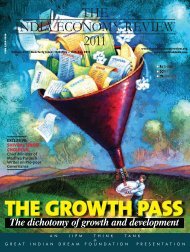Download - The India Economy Review
Download - The India Economy Review
Download - The India Economy Review
Create successful ePaper yourself
Turn your PDF publications into a flip-book with our unique Google optimized e-Paper software.
P LANNING P ARADIGM<br />
dams in Arunachal Pradesh are not free<br />
of controversies. <strong>The</strong> major controversies<br />
are: the adverse ecological impact, dis-<br />
placement and migration challenges, and<br />
rights of the indigenous people. Besides,<br />
confl ict between the upper riparian Arunachal<br />
Pradesh and lower riparian Assam<br />
over the right of the river since many of<br />
the rivers on those dams are constructed<br />
ultimately drains down to the river Brahmaputra.<br />
<strong>The</strong> issue of interstate confl ict<br />
over water also attracts importance as apprehensions<br />
prevail about provocation of<br />
ethnic confl icts. Fear also aggravates due<br />
to the existence of fragile relationship<br />
among various ethnic groups of the region.<br />
Looking at the scenario the questions<br />
those arise are: — is it worth building<br />
dams? Will dams really bring<br />
development? At this backdrop the case<br />
of Arunachal Pradesh is presented to<br />
understand the major challenges and issues<br />
a state might encounter while constructing<br />
a dam and the precautions it<br />
should take while planning for dams<br />
which will contribute in overcoming controversies<br />
and saving both time and<br />
money. Controversies have been factors<br />
for delaying dam project which increases<br />
the project cost.<br />
Introducing Arunachal Pradesh<br />
Arunachal Pradesh the Himalayan state<br />
in the North Eastern (NE) <strong>India</strong> attained<br />
statehood in February 20, 1987. <strong>The</strong> state<br />
has a population of 1,091,117 with a density<br />
of 13 persons per square kilometer is<br />
lowest in the country. It covers a territory<br />
of 83,734 square kilometer making it the<br />
biggest state in terms of geography in the<br />
NE region. <strong>The</strong> state has a long international<br />
border with Bhutan in the West<br />
(160 km), China in the North and Northeast<br />
(1,080km) and Myanmar in the east<br />
132 THE IIPM THINK TANK<br />
AP registered a high population<br />
growth of 36.8% in (1981-91) higher<br />
than the all <strong>India</strong> growth rate of 23.6%<br />
(440 km). <strong>The</strong> state receives a 300 centimeters<br />
of yearly rainfall and has 51,480 of<br />
forest cover. <strong>The</strong> road communication is<br />
very poor in the state. Only 15,356 kilometers<br />
for 100 square kilometer compared<br />
with 47.27 kilometers at the national level.<br />
<strong>The</strong>re are 16 districts, 57 Community<br />
Development Blocks 3649 villages. Most<br />
of the villages become inaccessible in<br />
rainy and winter sessions. 868,429 are<br />
rural population and 222,668 urban population,<br />
63.65 schedule tribes, literacy rate<br />
54.7 percent (2001 Census Report), male<br />
population 64.07 percent, female 44.24<br />
percent. Arunachal Pradesh registered a<br />
high population growth of 36.8 percent in<br />
(1981-91) higher than the all <strong>India</strong> growth<br />
rate of 23.6 percent.<br />
<strong>The</strong> state's economy is predominantly<br />
agricultural. <strong>The</strong> shifting cultivation<br />
known as Jhuming, occupies the central<br />
position in Arunachal Pradesh in the fi eld<br />
of Agriculture. However, traditional practice<br />
of Jhum cultivation is slowly diminishing.<br />
<strong>The</strong> state is also rich in forest resources<br />
and forest products are the next<br />
most signifi cant sector of economy. Arunachal<br />
is also ideal for horticulture and<br />
fruit orchards. <strong>The</strong> state is also rich in<br />
minerals like dolomite, graphitie, coal,<br />
YelloOrche, Marble. <strong>The</strong> state is trailing<br />
behind in industrial development. But<br />
with the socio-economic development<br />
there have been rise in the expectation of<br />
the people and the youth today are reluctant<br />
to take up the traditional ways of<br />
employments. This impinges upon the<br />
government the need to look for alternative<br />
ways of employment. Hence the state<br />
is in desperate need for enhancing its industrial<br />
growth.<br />
<strong>The</strong> topography of the state of Arunachal<br />
Pradesh shows a distinct pattern.<br />
Nestled in the high mountains the state is<br />
characterized by a hilly terrain interspersed<br />
with rivers and valleys. <strong>The</strong>re are<br />
10 major river basins in the state including:<br />
1) Tawang 2) Kameng 3) Dikring 4)<br />
Subanriri 5) Siang 6) Sisiri 7) Dibang 8)<br />
Lohit 9) Torap-Dehing and 10) Tissa.<br />
Besides there are numerous rivers originating<br />
from these basins and ultimately<br />
drain to Brahmaputra. <strong>The</strong>se river basins<br />
have identifi ed to be ideal for generation<br />
of hydropower. <strong>The</strong> state wants to utilize<br />
its potential and transform hydropower<br />
production as its fl agship industry to lift<br />
the economy of the state.<br />
Arunachal Pradesh has drafted a Hydropower<br />
policy with the ambitious plan<br />
of constructing nearly 100 dams to exploit<br />
its hydropower potential. Accordingly the<br />
state has signed Memorandum of Understanding<br />
(MoU) with both public and private<br />
companies. <strong>The</strong> major public sector<br />
companies are like - NEEPCOLtb, NHPC,<br />
NTPC(Hydro)Ltd and private companies<br />
include- GMR Energy and Jayprakash<br />
Associates. <strong>The</strong> state plans to produce<br />
30,00 MW of hydropower in 10 years. <strong>The</strong><br />
major projects those are currently been<br />
executed in the state are Ranganadi<br />
Project, the Subansiri project and the Tohal<br />
Project. <strong>The</strong> state is not only planning to<br />
sell the power domestically but also eyeing<br />
markets in neighbouring countries. <strong>The</strong><br />
state feels that it would be fl oating in “hydro<br />
dollars” as popularly said that the





